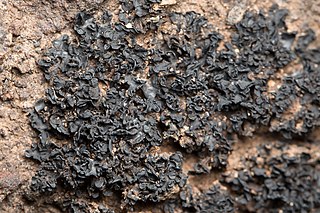
The Lichinaceae are a family of ascomycete fungi. Most species are lichenized with cyanobacteria, and have a distribution largely in temperate regions.
Gymnographopsis is a genus of lichen-forming fungi in the family Redonographaceae.

Anaptychia is a genus of lichen-forming fungi in the family Physciaceae. Anaptychia species are foliose (leafy) to fruticose (bushy) lichens. They have brown, thin-walled spores with a single septum, and a prosoplechtenchymatous upper cortex.
Everniopsis is a fungal genus in the family Parmeliaceae. It consists of a single species, the bark-dwelling lichen Everniopsis trulla, which occurs in Africa and South America.

Blennothallia is a genus of jelly lichens in the family Collemataceae. It has four species, which collectively have a cosmopolitan distribution.
Calycidium is a genus of lichen-forming fungi in the family Sphaerophoraceae. It has two species. It is one of the few lichen genera containing foliose (leafy) species that produce a mazaedium – a powdery mass of spores. Both species occur in Australasia and South America, where they grow on tree bark or on mosses.

Sporastatia is a genus of crustose lichens in the family Sporastatiaceae. It has four species. Sporastatia lichens are long-lived species that grow on siliceous or weakly calcareous rocks in arctic and alpine locales.
Apatoplaca is a fungal genus in the family Teloschistaceae. It is monotypic, containing a single species, the rare crustose lichen Apatoplaca oblongula, found in the United States.

Pseudocyphellaria glabra is a species of corticolous (bark-dwelling), foliose lichen in the family Peltigeraceae. It has a pale-green upper thallus surface, a white medulla and white pseudocyphellae.

Mastodia is a genus of lichen-forming fungi in the family Verrucariaceae. It has six species.
Gyronactis is a genus of lichen-forming fungi in the family Roccellaceae. It has two species. The genus was circumscribed by Damien Ernst and Anders Tehler in 2014, with G. asiatica assigned as the type species. This lichen, formerly placed in Lecanactis, is only known from the type locality in Myanmar. The genus name alludes to both its similarity with Lecanactis and the presence of gyrophoric acid in the thallus.
Podotara is a fungal genus in the family Pilocarpaceae. It is a monotypic genus, containing the single species Podotara pilophoriformis, an uncommon foliicolous (leaf-dwelling), crustose lichen that grows on Podocarpus totara, a species of podocarp tree endemic to New Zealand. Both the genus and the species were proposed in 1996.
Protothelenella is a genus of fungi in the family Protothelenellaceae. It contains 11 species, some of which form lichens. Protothelenella species have a crustose thallus with spherical to pear-shaped, dark brown to blackish perithecia. Microscopic characteristics of the genus include bitunicate asci with an amyloid tholus, and ascospores that are colourless and contain multiple internal partitions. Some species grow on acidic substrates including rocks, soil, bryophytes, plant detritus or rotten wood. Other species are lichenicolous (lichen-dwelling), growing on species of Solorina, Peltigera, Pseudocyphellaria, or Cladonia.
Aspiciliopsis is a genus of lichen-forming fungi in the family Trapeliaceae. It has two species, both of which occur in the Southern Hemisphere.

Buellia frigida is a species of saxicolous (rock-dwelling), crustose lichen in the family Caliciaceae. It was first described from samples collected from the British National Antarctic Expedition of 1901–1904. It is endemic to maritime and continental Antarctica, where it is common and widespread, at altitudes up to about 2,000 m (6,600 ft). The characteristic appearance of this lichen features shades of grey and black divided into small polygonal patterns. The crusts can generally grow up to 7 cm in diameter, although neighbouring individuals may coalesce to form larger crusts. One of the defining characteristics of the lichen is a textured surface with deep cracks, creating the appearance of radiating lobes. These lobes, bordered by shallower fissures, give the lichen a distinctive appearance and textured surface.
Austroparmeliella is a genus of lichen-forming fungi in the family Pannariaceae. It consists of five species, all of which are found in the Southern Hemisphere.
Siphulastrum is a genus of lichen-forming fungi in the family Pannariaceae. It has five species. The genus was circumscribed by Johannes Müller Argoviensis in 1889, with S. triste assigned as the type species.
Boreoplaca is a fungal genus in the family Ophioparmaceae. It comprises the single species Boreoplaca ultrafrigida, a saxicolous (rock-dwelling), squamulose lichen. Both the genus and species were described in 1994 by the Norwegian lichenologist Einar Timdal. The lichen is found in Eastern Siberia, the Russian Far East as well as in adjacent territories of north-east China, and in South Korea. The main characteristics of the lichen are its squamulose thallus, black lecideine apothecia, and Fuscidea-type asci.
Cyanoporina is a fungal genus in the division Ascomycota. The relationship of this taxon to other taxa within the division is unknown, and it has not yet been placed with certainty into any class, order, or family. The genus is monospecific, containing the single species Cyanoporina granulosa, a crustose lichen found in West Java, Indonesia.

Callome is a fungal genus in the family Collemataceae. It consists of the single species Callome multipartita, a saxicolous (rock-dwelling), crustose lichen found in Northern Africa, Europe, and North America.







